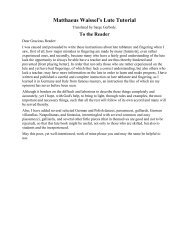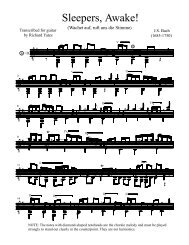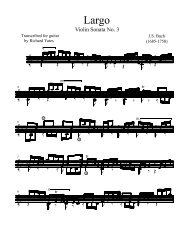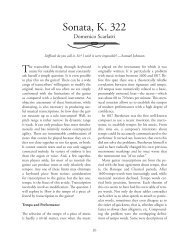The Transcriber's Art - Richard Yates Classical Guitar Transcriptions
The Transcriber's Art - Richard Yates Classical Guitar Transcriptions
The Transcriber's Art - Richard Yates Classical Guitar Transcriptions
Create successful ePaper yourself
Turn your PDF publications into a flip-book with our unique Google optimized e-Paper software.
apparently overlooked. <strong>The</strong> closest one seems to have been the modern guitar variant in<br />
which the fifth string is tuned to G and the sixth to D. <strong>The</strong> music of Tobias Hume,<br />
described and transcribed in Dr. Amelikina-Vera’s article, used Viol Way tuning, which<br />
is familiar to most guitarists from the rich legacy of the Renaissance lute.<br />
However, over time lyra-viol tunings evolved toward more resonant ones, that is,<br />
tunings that sounded the notes of triads and that fingerstyle guitarists today call “open”<br />
tunings. This probably occurred because of the idiosyncrasies of the lyra-viol itself. As a<br />
bowed instrument, its polyphonic capabilities were rather restricted. Specifically, any<br />
simultaneous notes, whether in a chord or through the coincidence of contrapuntal voices,<br />
had to be played on adjacent strings. Tunings were selected to minimize this constraint<br />
and to maximize the sympathetic resonance from the other strings.<br />
Also characteristic of the lyra-viol was a technique that went by the name of “<strong>The</strong><br />
Rule of Holds.” Christopher Simpson explained it like this in 1659: “When you set a<br />
Finger down, you are to let it rest there, (Playing the following Notes with other Fingers)<br />
until some occasion require the removing of it. This is done … to continue the sound of a<br />
Note when the Bow hath left it.” Thomas Mace, in his typically dyspeptic way<br />
complained that performers “seldom Hold their Hands according to the Propriety, and<br />
Necessity of the Composition … This Error … is the Grosest that can be Committed in<br />
the Kind …”<br />
So both the selection of tuning and the Rule of Holds helped in two ways: to allow<br />
sounded notes to continue to ring—thus facilitating independence of voices—and also to<br />
promote general resonance of the instrument. This limitation of the lyra-viol is especially<br />
significant for guitar transcriptions. After all, every sound that issues from our instrument<br />
happens after “the Bow [or in our case, finger] hath left it,” and since we cannot<br />
rummage around to find obliging tunings, close attention to the assignment of notes to<br />
fingers and strings is essential.<br />
Tuning systems<br />
Before turning to specific transcription examples and solutions, a brief explanation of<br />
notation is in order. Lyra-viol tablature uses letters to indicate frets: a= open string,<br />
b=first fret, c=second, etc. Tuning systems use these letters to list the frets at which<br />
strings are stopped to produce unisons. For instance, on the guitar we stop the second<br />
string at the fifth fret to make a unison with the first string; we stop the third string at the<br />
fourth fret, and so on. Shorthand for our guitar tuning could thus be written 54555 or,<br />
using letters for the frets, fefff. Similarly, “drop-D” tuning is feffh, and Renaissance lute<br />
tuning is ffeff. Without a lot of familiarity with these tunings they can be obscure to<br />
compare in writing, so for this article I will also translate them into actual note pitches.<br />
<strong>Guitar</strong>s are normally tuned “e 1 bgdAE.” For easy comparison I will always start with the<br />
first string and assume that it is the note “e 1 ” that we normally use. Please note that this is<br />
only to make tunings easy to compare and should not be literally tried on your guitar.<br />
Some tunings written in this form would pitch some strings high enough to cause damage<br />
to strings or bridges. If you want to try different tunings, and I strongly recommend you


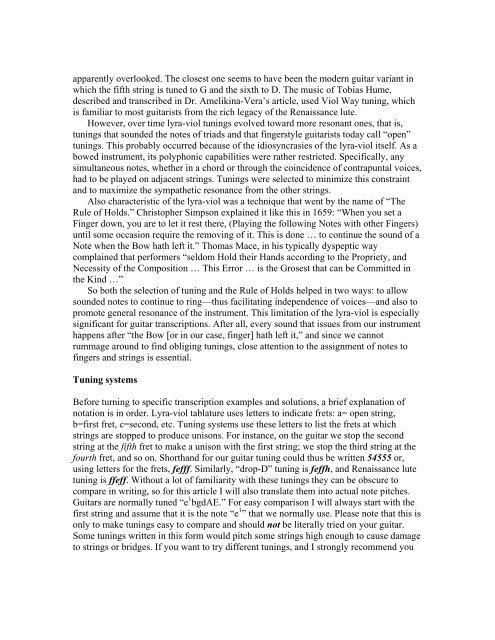


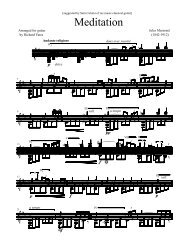
![Finale 2005b - [BWV846-Prelude in C.MUS]](https://img.yumpu.com/43978887/1/190x245/finale-2005b-bwv846-prelude-in-cmus.jpg?quality=85)
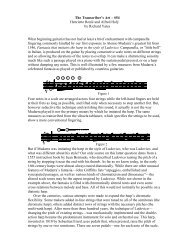
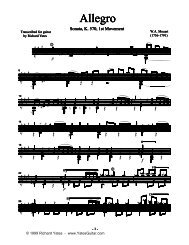

![Finale 2005b - [AirG-TAB.MUS] - Richard Yates Classical Guitar ...](https://img.yumpu.com/37104901/1/190x245/finale-2005b-airg-tabmus-richard-yates-classical-guitar-.jpg?quality=85)

